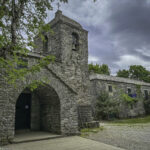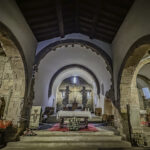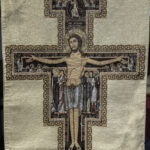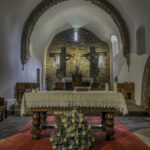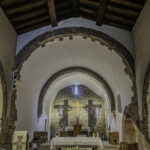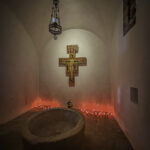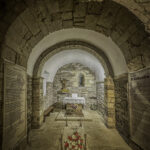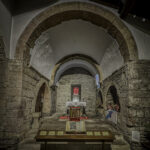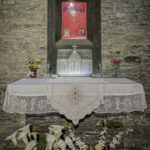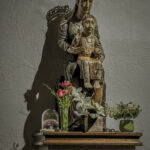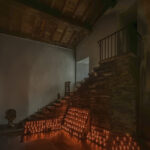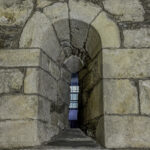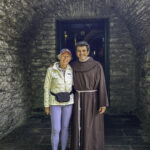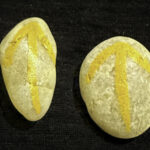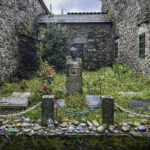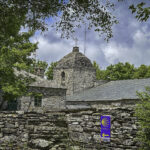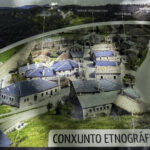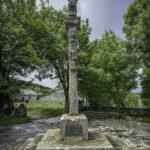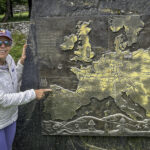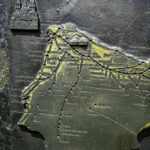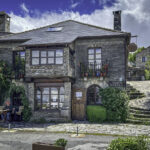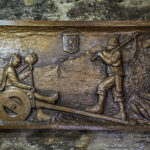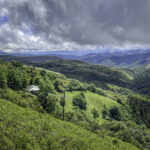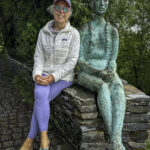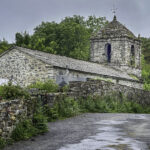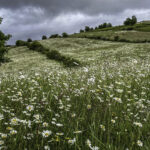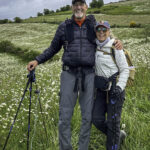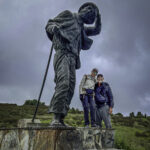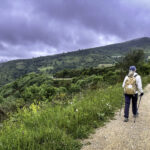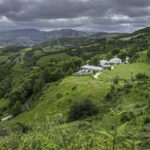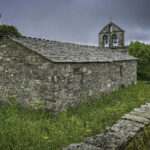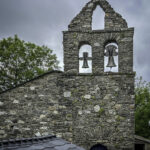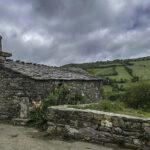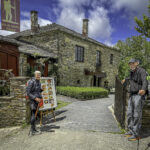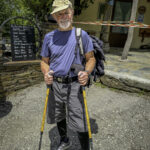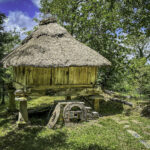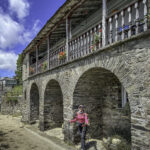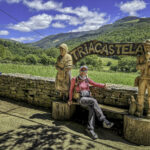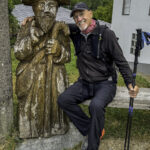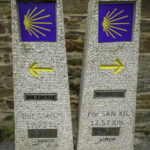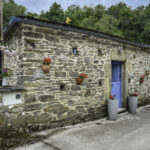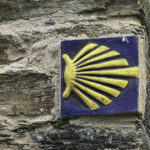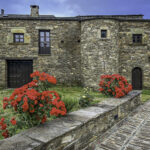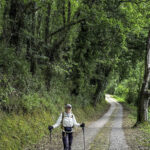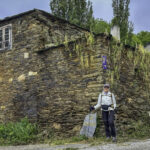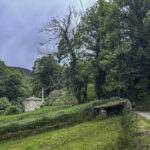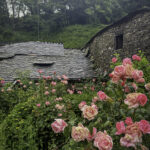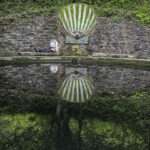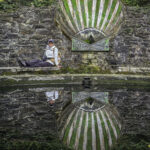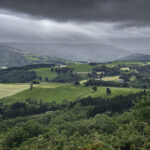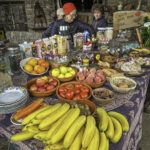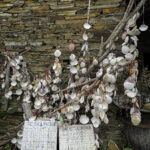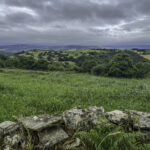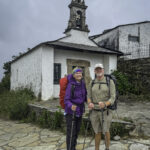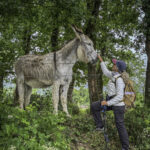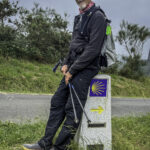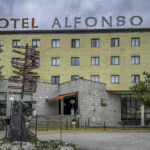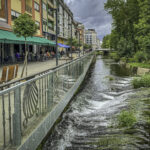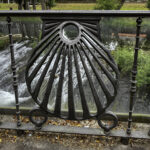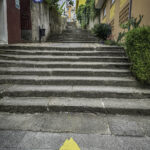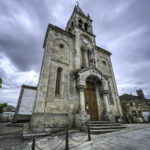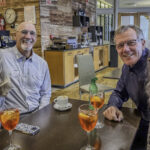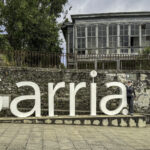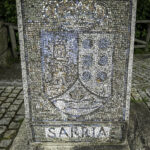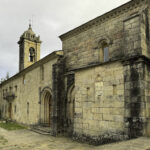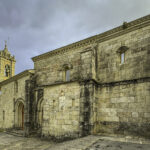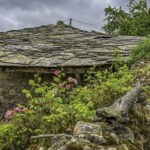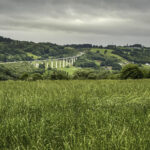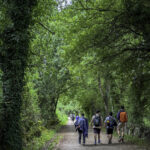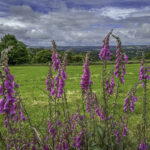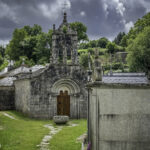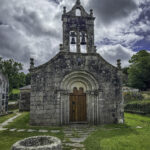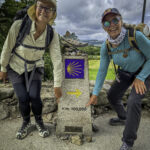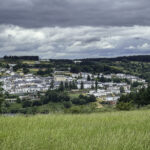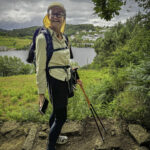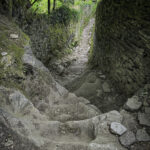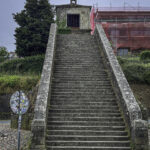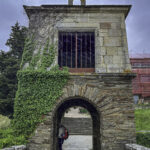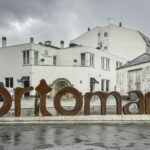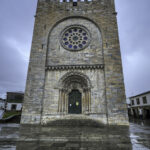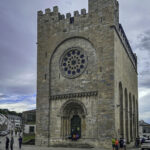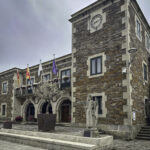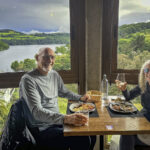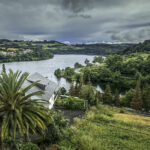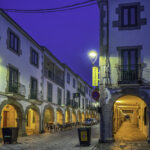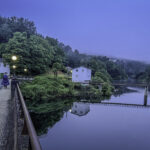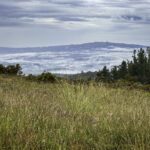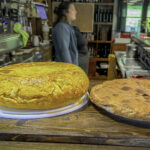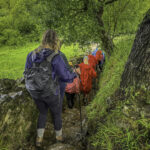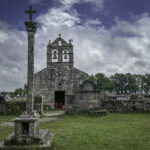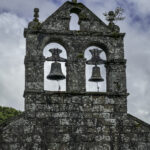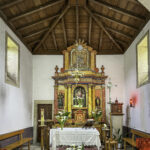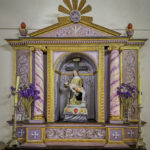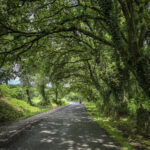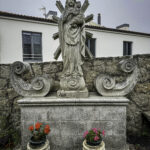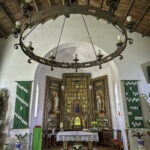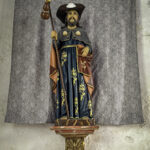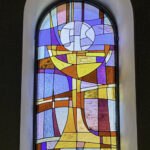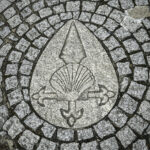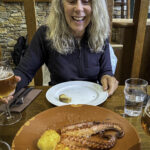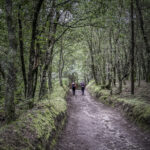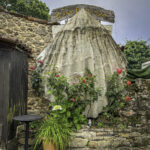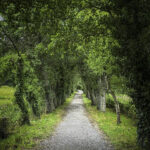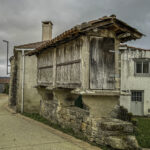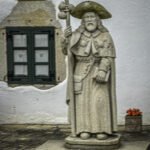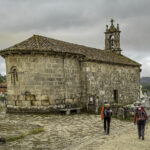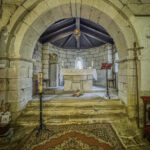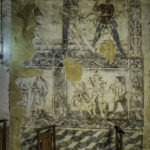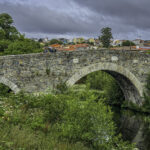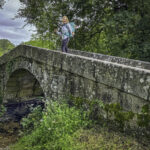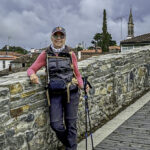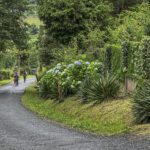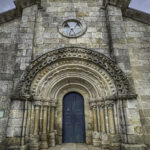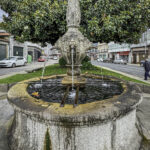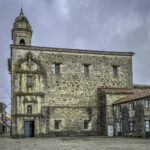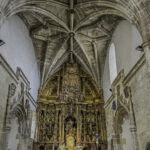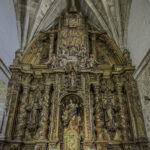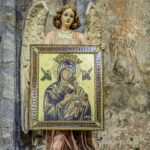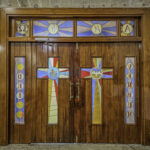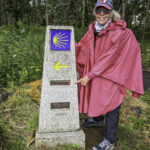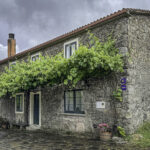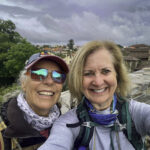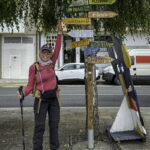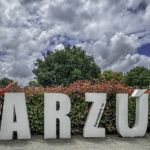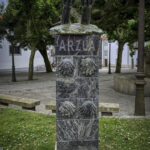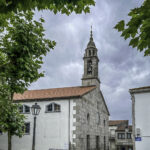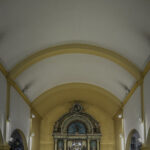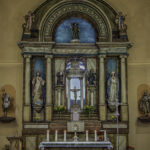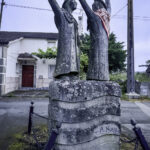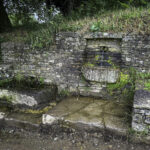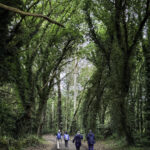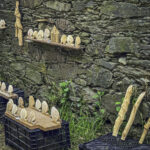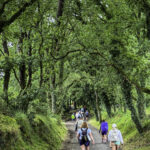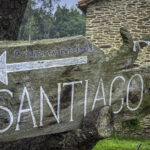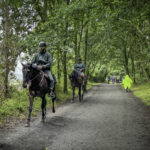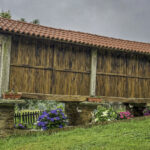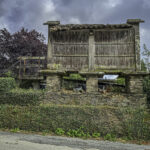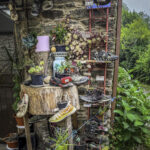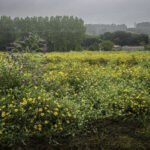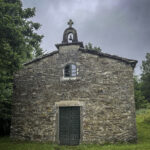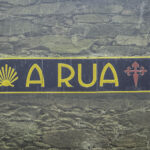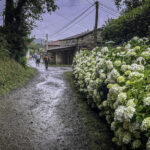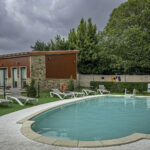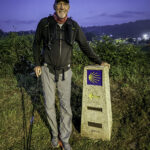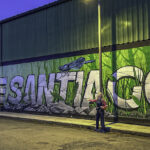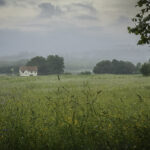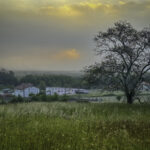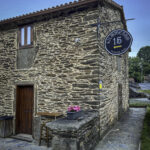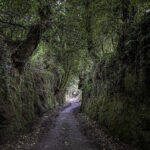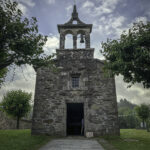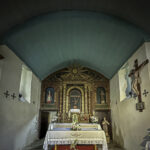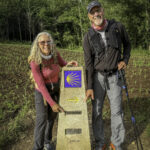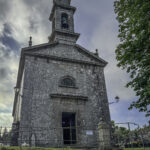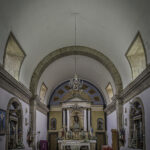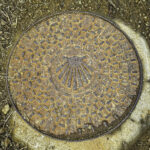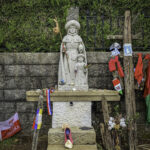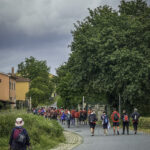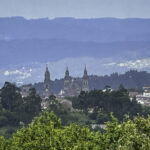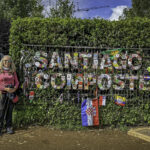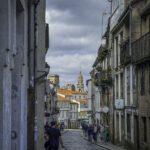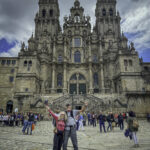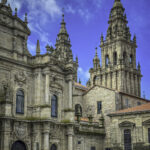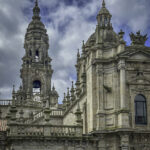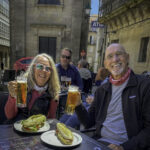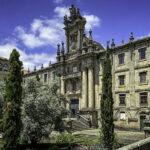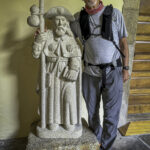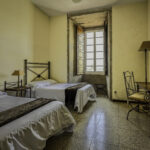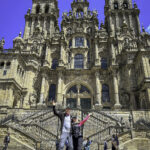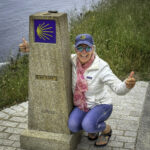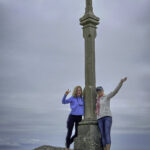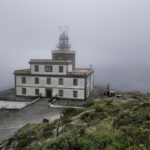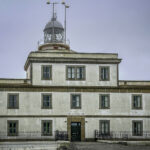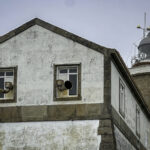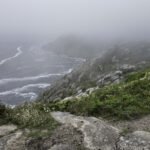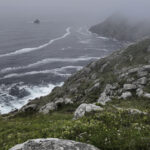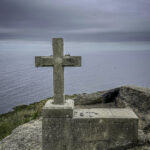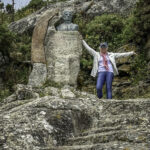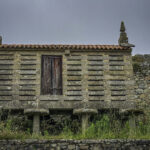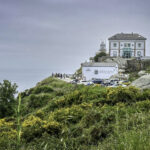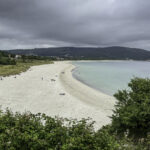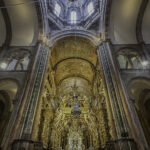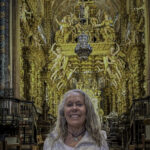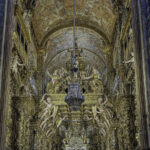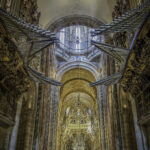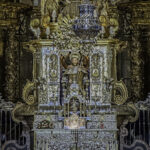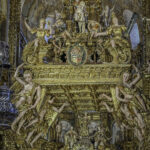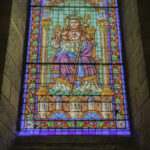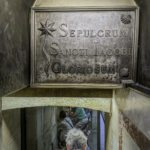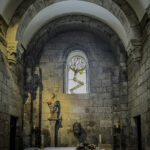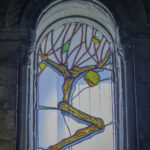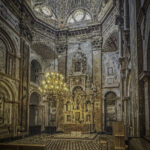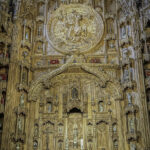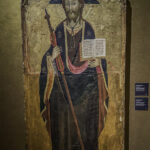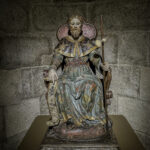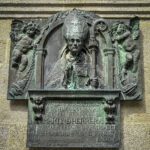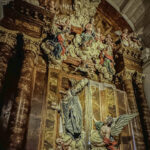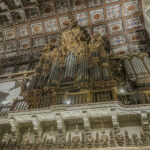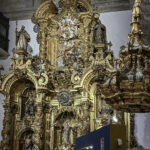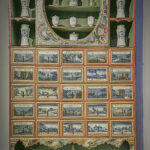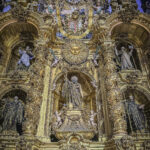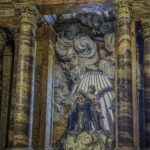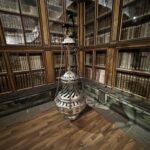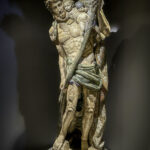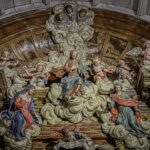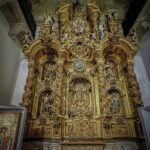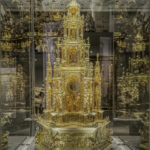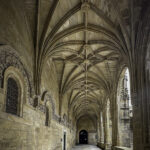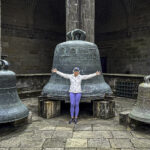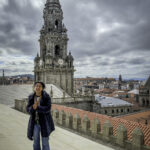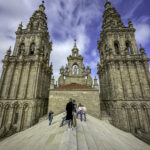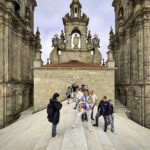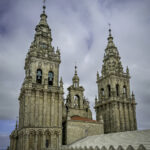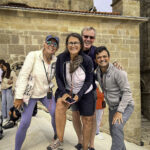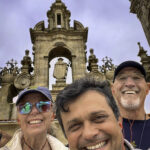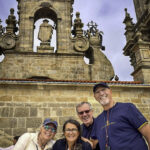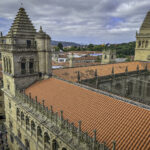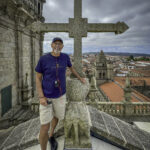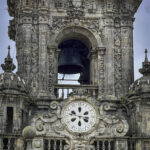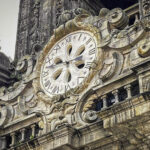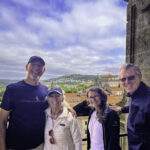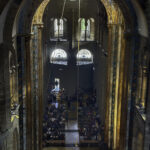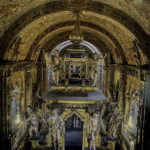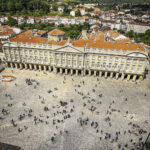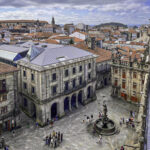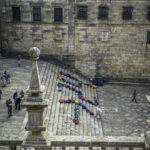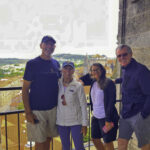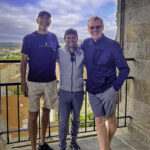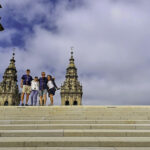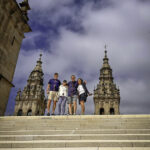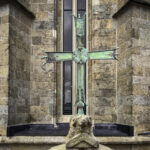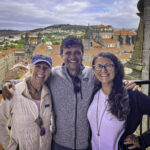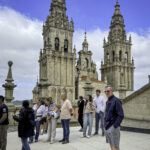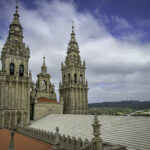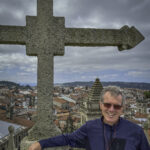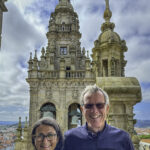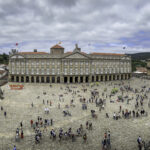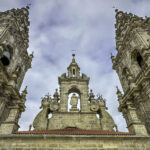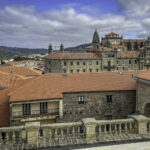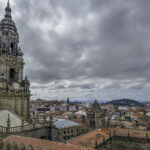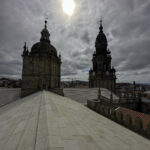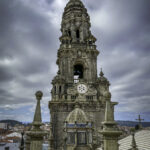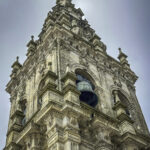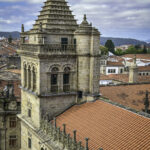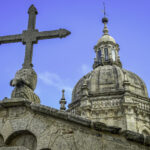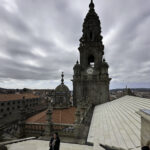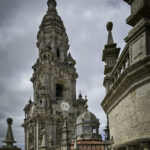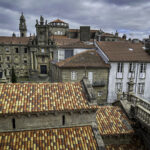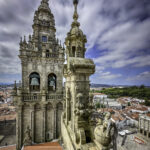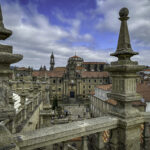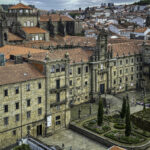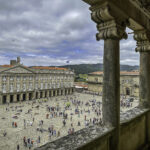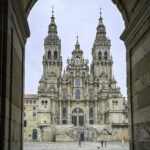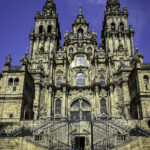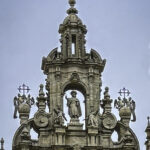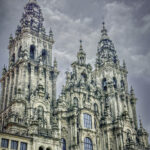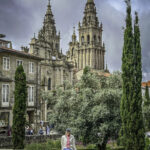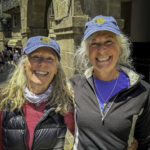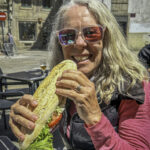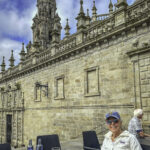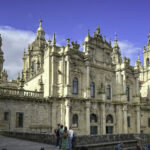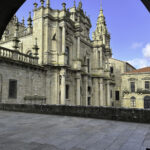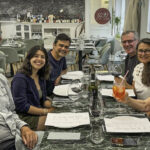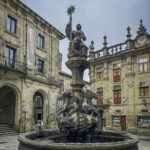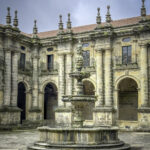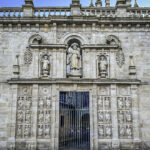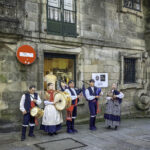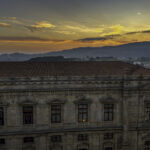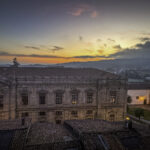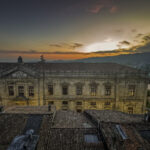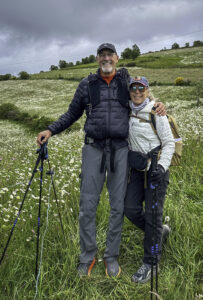 O’Cebreiro is a small, picturesque village located in the region of Galicia, Spain, and serves as a notable landmark on the Camino de Santiago. Nestled in the mountains, O’Cebreiro is renowned for its traditional stone houses with thatched roofs, known as pallozas, which offer a glimpse into the village’s ancient Celtic origins. The town has been a vital stop for pilgrims for centuries due to its strategic location and its rich history steeped in legend and faith.
O’Cebreiro is a small, picturesque village located in the region of Galicia, Spain, and serves as a notable landmark on the Camino de Santiago. Nestled in the mountains, O’Cebreiro is renowned for its traditional stone houses with thatched roofs, known as pallozas, which offer a glimpse into the village’s ancient Celtic origins. The town has been a vital stop for pilgrims for centuries due to its strategic location and its rich history steeped in legend and faith.
The Church of Santa María la Real in O’Cebreiro dates back to the 9th century, making it one of the oldest churches on the Camino de Santiago. This pre-Romanesque church is famous for the miracle of the Holy Grail, which, according to legend, occurred in the 14th century. It is said that during a snowstorm, a local peasant braved the weather to attend Mass, and the consecrated wine and bread miraculously turned into actual flesh and blood. This miracle, recognized by the Catholic Church, has made the church a site of profound spiritual significance for pilgrims.
O’Cebreiro and its church are deeply intertwined with the spiritual journey of the Camino de Santiago. The town’s serene, timeless atmosphere and the church’s historical and miraculous significance offer pilgrims a place of rest, reflection, and inspiration. As they continue their journey towards Santiago de Compostela, the experiences and history of O Cebreiro enrich their pilgrimage with a sense of connection to the centuries of faith and tradition that have preceded them. Click on thumbnail to view images
Day 32 O’Cebreiro Rest Day
Day 33 O’Cebreiro to Triacastela
Leaving the misty heights of O Cebreiro, we began a day of rolling ascents and descents through the lush, green landscapes of Galicia. The morning air was cool and damp, typical of this mountainous region, as the trail took us along ancient paths lined with moss-covered stone walls and dense forests of oak and chestnut.
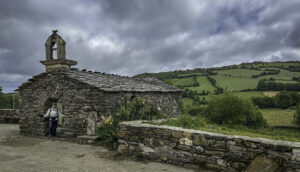 The route passed through several small, traditional Galician villages, each with its own quiet charm. One highlight was Liñares, where a small 17th-century chapel offered a peaceful stop. Further along, at Alto do Poio (1,335 meters), the highest point of the day, we paused to take in the panoramic views of the valleys below before beginning the long descent.
The route passed through several small, traditional Galician villages, each with its own quiet charm. One highlight was Liñares, where a small 17th-century chapel offered a peaceful stop. Further along, at Alto do Poio (1,335 meters), the highest point of the day, we paused to take in the panoramic views of the valleys below before beginning the long descent.
As we walked, the landscape shifted to rolling pastures, dotted with horreos—raised granaries unique to this region—standing as symbols of Galicia’s agricultural heritage. The sound of cowbells accompanied us, a reminder of the area’s deep connection to farming life.
Arriving in Triacastela, a town that’s been welcoming pilgrims since the early Middle Ages, we felt the warmth of its small but lively atmosphere. The name “Triacastela” refers to three castles that once stood here, though only traces remain. Historically, this was a key point where pilgrims would choose between two routes to Santiago—through Sarria or via the scenic detour to Samos and its famous Benedictine monastery.
The day’s walk, though challenging, was a beautiful immersion in Galicia’s rich landscape and history, setting the tone for the final stretch toward Santiago. Click on thumbnail to view images
Day 34 Triacastela to Sarria
 Leaving Triacastela, we faced a choice between two scenic routes—one passing through the ancient Monasterio de Samos and the other following a shorter, more direct path through San Xil. We chose the San Xil route, known for its quiet beauty and rolling Galician countryside.
Leaving Triacastela, we faced a choice between two scenic routes—one passing through the ancient Monasterio de Samos and the other following a shorter, more direct path through San Xil. We chose the San Xil route, known for its quiet beauty and rolling Galician countryside.
The trail led us through peaceful chestnut and oak forests, with morning mist clinging to the hills—a classic Galician scene. Small hamlets like A Balsa and Montán offered glimpses of rural life, with stone farmhouses, grazing cattle, and the ever-present sound of cowbells.
The climb to Alto de Riocabo rewarded us with stunning views over green valleys, after which a long, gentle descent brought us through shaded woodland paths lined with mossy stone walls, remnants of centuries-old farming traditions.
As we approached Sarria, the Camino took on a different energy. Known as the most popular starting point for the pilgrimage (thanks to its location just over 100 km from Santiago, the minimum required to earn a Compostela), Sarria was bustling with fresh-faced pilgrims joining the journey. The town itself holds a rich history, with medieval churches like Iglesia de Santa Mariña and remnants of its 13th-century castle.
Arriving in Sarria felt like crossing an invisible threshold—closer than ever to Santiago, with anticipation building for the final days of walking. The mix of veteran pilgrims and new travelers created a dynamic energy that was both grounding and inspiring. Click on thumbnail to view images
Day 35 Sarria to Portomarin
Leaving the lively streets of Sarria, we set out on one of the most popular and scenic stretches of the Camino. The trail wound through lush Galician countryside, with ancient oak and chestnut forests, rolling green pastures, and tiny hamlets where time seemed to stand still.
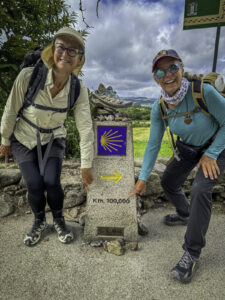 This stage is famous for its many corredoiras—narrow, stone-lined paths that have guided pilgrims for centuries. Morning mist hung low over the fields, creating a quiet, almost mystical atmosphere as we passed through villages like Barbadelo, home to the 12th-century Igrexa de Santiago, with its beautifully preserved Romanesque portal.
This stage is famous for its many corredoiras—narrow, stone-lined paths that have guided pilgrims for centuries. Morning mist hung low over the fields, creating a quiet, almost mystical atmosphere as we passed through villages like Barbadelo, home to the 12th-century Igrexa de Santiago, with its beautifully preserved Romanesque portal.
The Camino gently rose and fell, crossing small rivers and farmlands, where friendly local farmers and their ever-present dogs greeted us. At Ferreiros, we passed the 100-kilometer marker, a significant milestone for every pilgrim, marking the final stretch toward Santiago.
A long descent through shaded woodlands eventually brought us to the Río Miño, where Portomarín awaited on the opposite bank. The modern town, with its distinctive white arcades, sits above the river on a hill—relocated stone-by-stone in the 1960s when the Belesar Reservoir flooded the original village.
Crossing the long bridge into Portomarín, we climbed the staircase that leads to the Igrexa de San Nicolás, a fortress-like 12th-century church that once stood in the old town below. The day’s walk had been a beautiful blend of nature, history, and the anticipation of nearing Santiago. Portomarín’s lively central square was the perfect place to rest and reflect on how far we’d come. Click on thumbnail to view images
Day 36 Portomarin to Palas De Rei
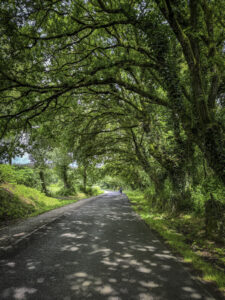 Leaving Portomarín, we crossed the Río Miño once more, ascending steadily through misty forests and quiet farmland. The early morning climb rewarded us with sweeping views of the reservoir below, as the Camino wound through rural Galicia’s patchwork of fields and tiny hamlets.
Leaving Portomarín, we crossed the Río Miño once more, ascending steadily through misty forests and quiet farmland. The early morning climb rewarded us with sweeping views of the reservoir below, as the Camino wound through rural Galicia’s patchwork of fields and tiny hamlets.
The trail passed through villages like Gonzar and Ventas de Narón, where we stopped briefly at the small Igrexa de Santa María, a church with roots dating back to the Middle Ages. This section of the Camino follows ancient Roman roads, and the gentle rhythm of walking through oak and eucalyptus forests made for a peaceful morning.
At Ligonde, we crossed a historically significant spot—once a burial site for medieval pilgrims and a resting place for Emperor Charles V in the 16th century. Nearby, a humble cruceiro (stone cross) reminded us of the Camino’s deep spiritual history.
The path alternated between forested trails and open countryside, with the ever-present sound of cowbells and the sight of hórreos—Galicia’s traditional raised granaries—dotting the landscape.
As we approached Palas de Rei, the anticipation of reaching the final stages of the pilgrimage grew stronger. Historically a royal stopping point along the Camino (hence its name, “Palace of the King”), the town offered a warm welcome, with its cozy cafés and a sense of camaraderie among fellow pilgrims. With Santiago now just days away, each step felt more meaningful, drawing us closer to the journey’s ultimate destination. Click on thumbnail to view images
Day 37 Palas De Rei to Arzua
Leaving Palas de Rei at dawn, we set out on one of the longest but most rewarding stretches of the Camino. The trail led us through the heart of Galicia’s countryside, a rolling landscape of forests, farmland, and stone-built villages that seemed untouched by time.
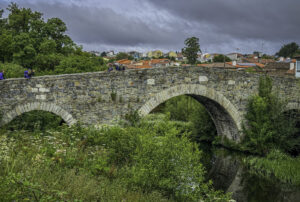 The morning took us to San Xulián do Camiño, where the small Romanesque church stood quietly, its weathered stone façade a testament to centuries of pilgrims passing by. As we continued, the path alternated between shaded woodland trails and open fields, with ancient corredoiras (stone-lined paths) guiding our way.
The morning took us to San Xulián do Camiño, where the small Romanesque church stood quietly, its weathered stone façade a testament to centuries of pilgrims passing by. As we continued, the path alternated between shaded woodland trails and open fields, with ancient corredoiras (stone-lined paths) guiding our way.
Crossing into the province of A Coruña, we arrived in Melide, a town famous for its pulpo a la gallega—Galician-style octopus. We couldn’t resist stopping at one of the town’s pulperías for a quick, flavorful lunch, savoring the tender octopus sprinkled with paprika and olive oil.
From Melide, the Camino joined with the route from Oviedo, the Camino Primitivo, and the influx of new pilgrims added fresh energy to the walk. The afternoon’s terrain was a mix of gentle hills and eucalyptus forests, with the scent of the trees hanging in the air.
A steady rhythm brought us through small villages like Boente, with its simple yet beautiful Igrexa de Santiago, and Castañeda, where medieval pilgrims once deposited stones they’d carried from the Iron Cross as symbolic penance.
Arriving in Arzúa, known for its creamy queixo Arzúa-Ulloa cheese, we felt the growing excitement of being just two days from Santiago. The town, a key Camino hub, offered a comforting blend of pilgrim camaraderie and quiet anticipation—a fitting place to rest before the final stretch of this incredible journey. Click on thumbnail to view images
Day 38 Arzua to Rua
Leaving Arzúa, we set out through Galicia’s lush countryside, with the morning mist hanging low over rolling green hills. This penultimate stage of the Camino was quieter, allowing for reflection as we passed through serene forests of eucalyptus and oak, with the occasional farmhouse or small hamlet breaking the landscape.
 The trail wound through villages like Pregontoño and A Peroxa, where stone chapels and weathered crosses stood as silent reminders of the pilgrimage’s deep history. We stopped briefly in the village of Salceda, a common resting point, where a small memorial honors a pilgrim who died on this stretch—a poignant reminder of the journey’s physical and emotional intensity.
The trail wound through villages like Pregontoño and A Peroxa, where stone chapels and weathered crosses stood as silent reminders of the pilgrimage’s deep history. We stopped briefly in the village of Salceda, a common resting point, where a small memorial honors a pilgrim who died on this stretch—a poignant reminder of the journey’s physical and emotional intensity.
The path offered gentle ascents and descents, with shaded woodland trails giving way to open fields dotted with hórreos (Galician granaries) and grazing cattle. A sense of anticipation built with each step, knowing Santiago was now just a day away.
By the time we reached A Rúa, a small but welcoming village, the atmosphere among pilgrims had shifted. Conversations turned to thoughts of arriving in Santiago, to the emotions of finishing a journey that had, for many, been life-changing. The evening was quiet, with the soft hum of anticipation filling the air.
With only a short walk remaining, A Rúa felt like a fitting place to gather our thoughts before the final approach to the Cathedral of Santiago de Compostela. The end was near, but the Camino still had one more day of magic to offer. Click on thumbnail to view images
Day 39 Rua to Santiago De Compostela
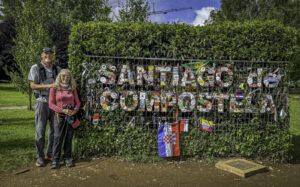 The final leg of our journey began in the early morning mist of A Rúa, with Santiago de Compostela just 20 kilometers away. There was a quiet excitement in the air, as if every pilgrim on the path felt the same mix of anticipation and reflection.
The final leg of our journey began in the early morning mist of A Rúa, with Santiago de Compostela just 20 kilometers away. There was a quiet excitement in the air, as if every pilgrim on the path felt the same mix of anticipation and reflection.
The trail led us through eucalyptus forests and small hamlets, the scent of damp earth and wood smoke lingering as we passed through villages like Pedrouzo and Lavacolla. The latter holds special significance—historically, pilgrims would wash in the stream here to purify themselves before entering Santiago, a tradition that added a spiritual weight to our arrival.
The climb to Monte do Gozo (“Mount of Joy”) was both literal and symbolic. Reaching its summit, we caught our first glimpse of the spires of Santiago’s cathedral in the distance. It was a moment of awe and gratitude, standing where millions of pilgrims have paused over the centuries, their journey nearly complete.
The descent into the city felt surreal—modern buildings and busy streets gradually giving way to the ancient heart of Santiago. Entering the old town, we followed the sound of bagpipes echoing through the stone streets, guiding us toward the Praza do Obradoiro.
Finally, standing before the grand façade of the Cathedral of Santiago de Compostela, the emotions of the journey washed over us—joy, exhaustion, and a deep sense of connection to the countless pilgrims who had come before. We embraced, taking in the moment, knowing this wasn’t just the end of a walk but the culmination of an extraordinary shared experience.
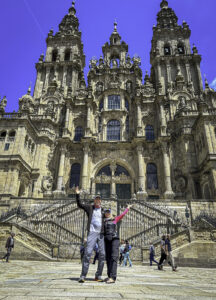 For centuries, arriving in Praza do Obradoiro, the grand square in front of the Cathedral of Santiago de Compostela, has marked the emotional and spiritual culmination of the Camino. It’s a moment pilgrims dream of for weeks, or even years—a final step that’s as symbolic as it is physical.
For centuries, arriving in Praza do Obradoiro, the grand square in front of the Cathedral of Santiago de Compostela, has marked the emotional and spiritual culmination of the Camino. It’s a moment pilgrims dream of for weeks, or even years—a final step that’s as symbolic as it is physical.
As pilgrims enter the plaza, the sight of the cathedral’s towering Baroque façade often evokes a deep, visceral reaction. After walking hundreds of kilometers, through mountains, forests, and ancient villages, reaching this sacred space feels like a rite of passage—an acknowledgment of endurance, faith, and personal transformation. The name “Obradoiro,” meaning “workshop,” hints at the centuries of labor that went into building both the cathedral and, metaphorically, the inner journey of each pilgrim.
The tradition of lying down in the center of the plaza, gazing up at the cathedral’s spires, is more than just a photo opportunity—it’s a silent communion with the millions who have stood in that same place, overcome with emotion, gratitude, and relief. Some pilgrims enter the square laughing, others in tears, and many simply sit quietly, allowing the weight of their journey to settle over them.
Beyond the physical arrival, the plaza serves as a threshold between the pilgrimage and what comes after. It’s a space of closure and new beginnings—a reminder that the Camino doesn’t truly end in Santiago, but continues in the hearts and lives of those who walk it. This powerful, shared experience binds pilgrims across cultures and centuries, creating a connection that lingers long after the journey is complete.
That evening, after receiving our Compostela certificates and attending the Pilgrim’s Mass, we reflected on the miles we’d traveled, the friendships forged, and the lessons learned. The Camino had given us more than we could have imagined—and, as we watched the sunset over Santiago’s rooftops, we knew its spirit would stay with us long after we returned home. Click on thumbnail to view images
Day 40 Day Trip to Finistera
 On our first day off from walking we took a taxi to Finisterre, or Fisterra in Galician, a coastal town located on the westernmost point of Spain’s Iberian Peninsula. The name “Finisterre” derives from the Latin “Finis Terrae,” meaning “end of the earth,” reflecting the ancient belief that this rugged, windswept promontory marked the edge of the known world. Historically, it has been a place of deep spiritual and mystical significance, even before the rise of Christianity, with ancient pagan rituals being conducted in honor of the sun setting into the Atlantic Ocean.
On our first day off from walking we took a taxi to Finisterre, or Fisterra in Galician, a coastal town located on the westernmost point of Spain’s Iberian Peninsula. The name “Finisterre” derives from the Latin “Finis Terrae,” meaning “end of the earth,” reflecting the ancient belief that this rugged, windswept promontory marked the edge of the known world. Historically, it has been a place of deep spiritual and mystical significance, even before the rise of Christianity, with ancient pagan rituals being conducted in honor of the sun setting into the Atlantic Ocean.
For pilgrims on the Camino de Santiago, Finisterre holds special significance as an extension of the traditional pilgrimage route. After reaching Santiago de Compostela, many pilgrims choose to continue their journey for an additional three days to reach Finisterre, which symbolizes the true conclusion of their spiritual quest. The journey to Finisterre is often seen as a time for reflection and a chance to contemplate the pilgrimage’s end while gazing out over the vast expanse of the ocean.
Upon reaching Finisterre, pilgrims often visit the iconic lighthouse, Faro de Fisterra, and perform symbolic rituals such as burning their worn-out clothes or boots, signifying a new beginning or the shedding of their old selves. The pilgrimage to Finisterre encapsulates the themes of completion and renewal, adding an extra layer of depth to the Camino de Santiago experience. Finisterre’s dramatic landscapes and historical aura provide a fitting and poignant conclusion to the long and transformative journey of the Camino. Click on thumbnail to view images
Day 41 Santiago De Compostela
Santiago de Compostela, the capital of Galicia in northwestern Spain, is renowned as the final destination of the Camino de Santiago, a pilgrimage route dating back to the early Middle Ages. The city’s historical and cultural heritage is deeply intertwined with the legend of Saint James the Greater, one of Jesus Christ’s apostles. According to tradition, his remains were miraculously discovered in the 9th century in what is now Santiago de Compostela, leading to the construction of a shrine that would evolve into the city’s iconic cathedral.
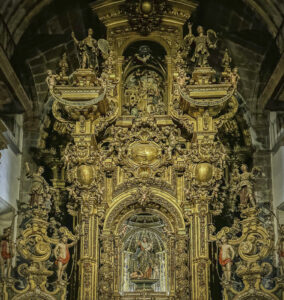 The Santiago de Compostela Cathedral, an architectural masterpiece of Romanesque, Gothic, and Baroque styles, stands as a symbol of the pilgrimage. Built primarily between the 11th and 13th centuries, it houses the relics of Saint James in a silver crypt beneath the high altar. The cathedral’s magnificent façade, known as the Obradoiro, its grand Portico of Glory, and the Botafumeiro, a massive swinging incense burner, are among its many notable features. These elements not only highlight the cathedral’s architectural grandeur but also its profound religious significance.
The Santiago de Compostela Cathedral, an architectural masterpiece of Romanesque, Gothic, and Baroque styles, stands as a symbol of the pilgrimage. Built primarily between the 11th and 13th centuries, it houses the relics of Saint James in a silver crypt beneath the high altar. The cathedral’s magnificent façade, known as the Obradoiro, its grand Portico of Glory, and the Botafumeiro, a massive swinging incense burner, are among its many notable features. These elements not only highlight the cathedral’s architectural grandeur but also its profound religious significance.
As the culmination point of the Camino de Santiago, the city and its cathedral hold immense spiritual significance for pilgrims. The journey to Santiago de Compostela is seen as a path of penance, reflection, and spiritual renewal. Upon reaching the cathedral, pilgrims often attend the Pilgrim’s Mass and visit the crypt of Saint James, marking the completion of their pilgrimage with a sense of accomplishment and spiritual fulfillment. Santiago de Compostela and its cathedral thus embody the enduring legacy of faith, tradition, and community that defines the Camino de Santiago. Click on thumbnail to view images
Cathedral Interior and the Monastery and Cathedral Museum Tours
Cathedral Tower Roof Tour
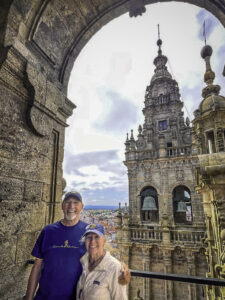 A highlight of our time in Santiago de Compostela was the amazing Tower Roof Tour of the Cathedral with our pilgrim friends, Claire and Julian from Ottawa, and Gustavo from Brazil.
A highlight of our time in Santiago de Compostela was the amazing Tower Roof Tour of the Cathedral with our pilgrim friends, Claire and Julian from Ottawa, and Gustavo from Brazil.
Climbing to the roof of the Cathedral of Santiago de Compostela offers a perspective few pilgrims get to see—a breathtaking panorama of the city and an intimate look at the cathedral’s architectural evolution. The experience feels like stepping back in time, walking where stonemasons once worked centuries ago, carefully constructing the towering sanctuary that has welcomed millions of pilgrims.
The guided tour begins inside, winding through ancient staircases before emerging onto the rooftop. The first sight is striking—the cathedral’s intricate spires reaching skyward, adorned with weathered carvings that have stood watch over Santiago for generations. From here, the city unfolds below: terracotta rooftops, the winding medieval streets, and beyond them, the lush Galician hills.
Walking across the sloping stone tiles, we could imagine the medieval builders who once labored here, carefully fitting each piece to withstand time and the elements. The tour highlights architectural details often missed from the ground—Romanesque foundations, Gothic additions, and Baroque embellishments, each layer telling a story of devotion and craftsmanship.
Perhaps the most moving moment is standing directly above the Portico de la Gloria, where countless pilgrims have entered below, their journeys culminating in the embrace of Saint James. From this vantage point, it’s easy to reflect on the Camino itself—on the footsteps that have led here, the history that surrounds it, and the sense that, even from above, Santiago remains a city shaped by faith, perseverance, and the spirit of those who arrive at its doors. Click on thumbnail to view images
Farewell to Santiago De Compostela
Saying goodbye to the Camino de Santiago is not like leaving an ordinary trip behind—it feels more like parting with a dear friend. The journey has been more than just kilometers walked; it has been a tapestry of shared laughter, deep conversations, and quiet moments of reflection. Along the way, we have met fellow pilgrims from all corners of the world, each with their own story, each leaving a mark on our experience.
The friendships forged on the trail, often with just a shared meal or a few miles walked side by side, feel profound. Whether it was offering words of encouragement on a steep climb or celebrating together in Santiago’s Praza do Obradoiro, these connections have become part of our Camino. We may have arrived as strangers, but we leave as part of something bigger—a community bonded by the road.
As we take our final steps away from this sacred path, we carry with us more than memories; we carry the lessons of the Camino—gratitude, perseverance, and the beauty of simple moments. Though our physical journey has ended, the Camino continues in our hearts, shaping the way we move forward in life. Buen Camino, always. Click on thumbnail to view images


